The Days Are Not Always The Same
Written by: Alex Maldonado-Lizardi and Xiomara Cintron-Garcia who serve with the Christian Centre for Justice, Peace and Nonviolent Action (Justapaz), Bogota, Colombia
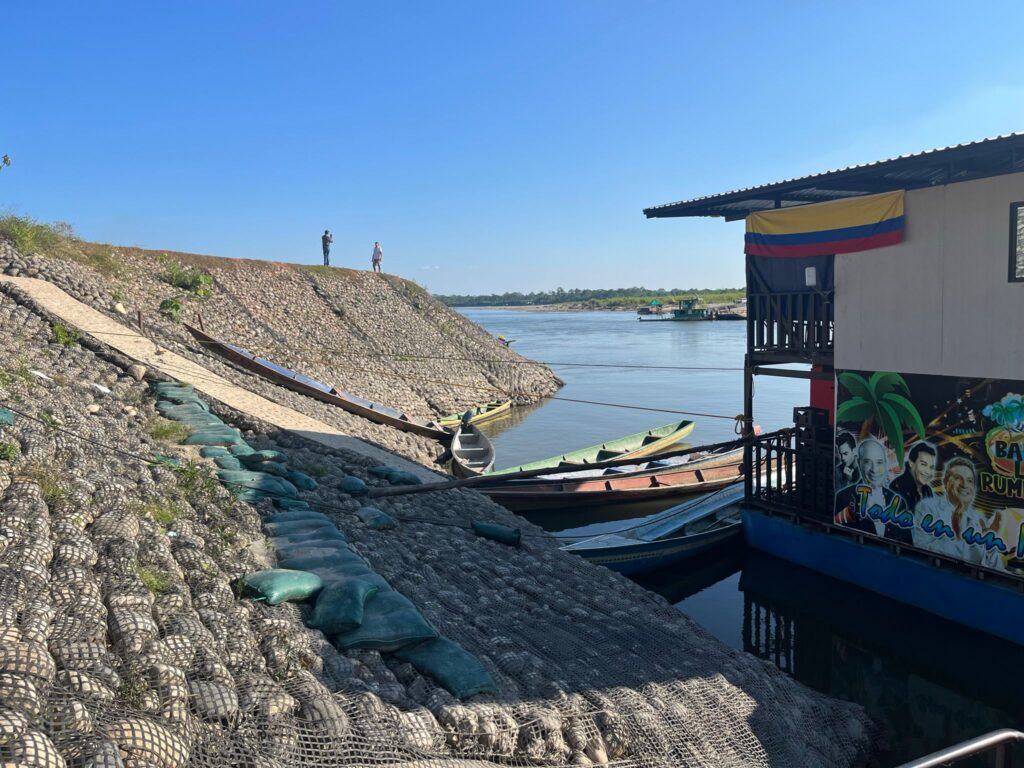
On Friday, August 25, from Justapaz, four of us arrived in the shade of the mango tree in front of the temple of the Iglesia Cristiana Luz de Paz in Putumayo with cardboard, markers, colored threads, and the shape of a wooden heart by pieces, disassembled. The objective for those days was to contribute to the reconciliation processes between signatories of the Peace Agreement of 2016, and victims of the Colombian armed conflict from different regions in Putumayo. Corresponding to what is stated in point 5 of the Final Agreement: “the satisfaction of the rights of the victims is the reconciliation of all Colombian citizens to walk on paths of civility and coexistence.” But, Putumayo is a department with 287,974 people recognized as victims of the armed conflict of the 9,555,446 who are grieving in the country. According to this figure, 84% of the Putumayo department has been a victim of the conflict. How does a country of so many victims reconcile with those responsible? How would we ensure that 60 victims and 6 signatories are on the path of reconciliation?
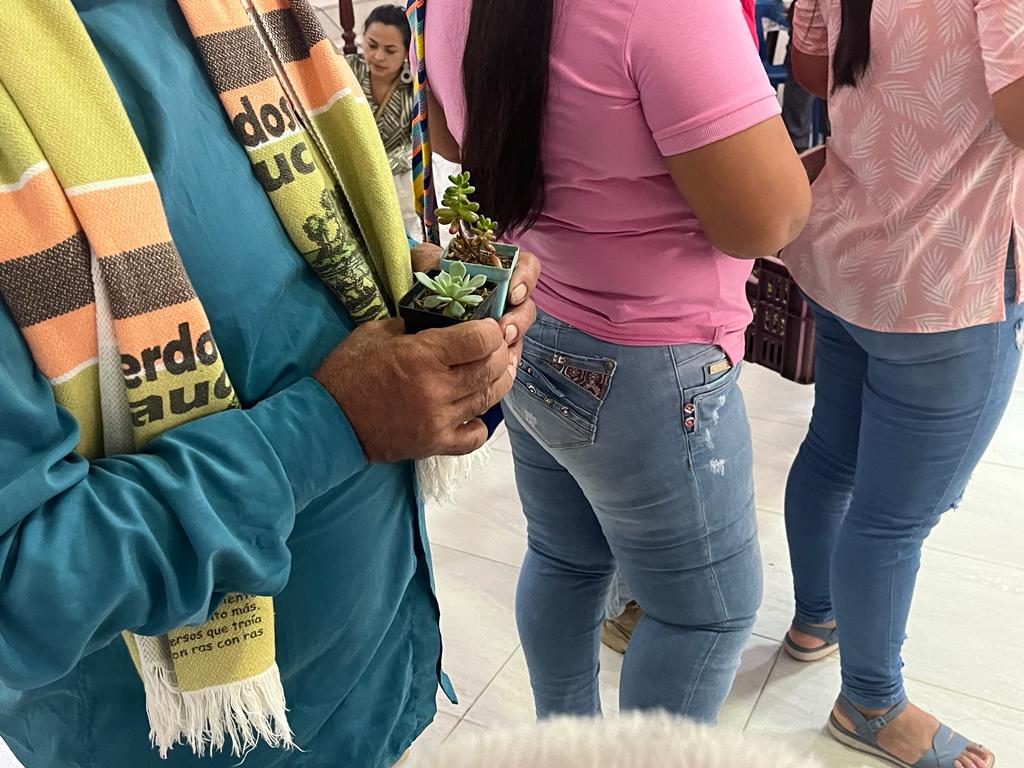
The six peace signers arrived by river, on a barge as long as an ear of wheat and metals. They traveled by van and then crossed the river by boat and again by road to the church. Little by little they are reformulating everyday life. Some formed the ranks of the Revolutionary Armed Forces of Colombia (FARC) for 13 years or more. One of them is now of old age and was part of the FARC for more than 40 years. “A lifetime in the mountains,” he says.
How do they talk about reconciliation? For them, the signing and the forgiveness processes are not only humanitarian actions, but political actions. Therefore, reconciliation has methodological problems that cannot be resolved by faith alone. Because the great paradox of violence in this country has an ordering factor in the political, social, and economic life of the people. To the extent that this order is imposed by the war, the treaties, the agreements, the conventions, the rights, and have become degraded by it.
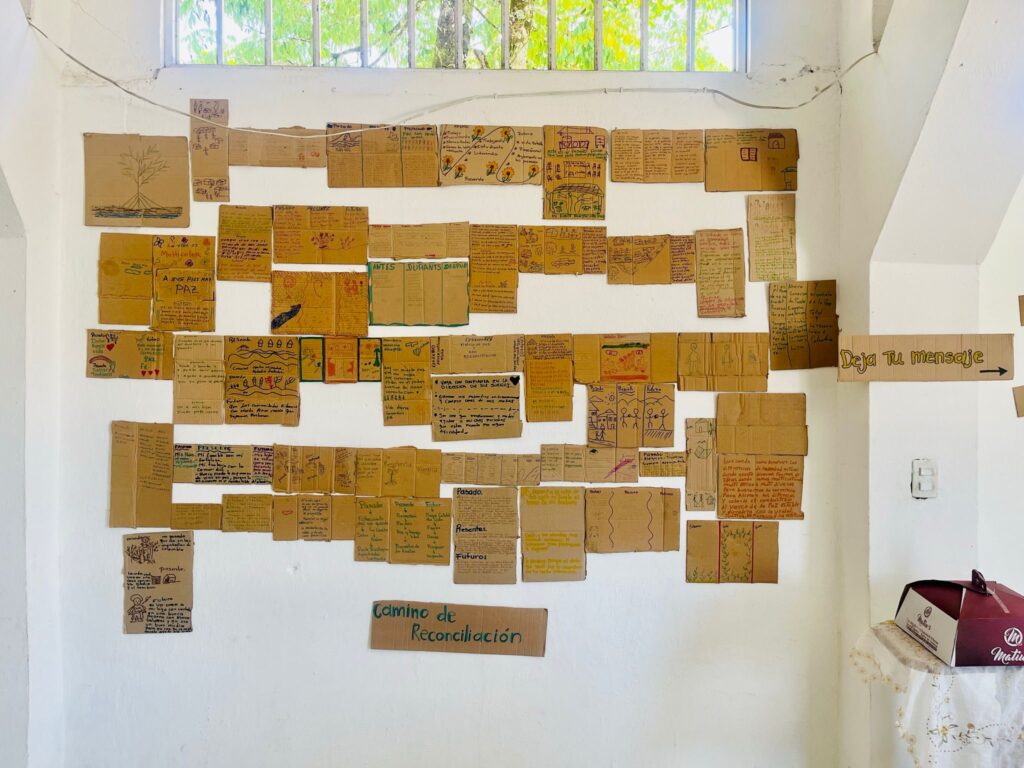
The meeting was a symbolic and spiritual space of reconciliation. It had three moments to learn about people’s life stories and understand the capacity for forgiveness and reconciliation of both the signatories and the victims. With each group we wrote and carefully drew our life paths on pieces of cardboard that we later collected and silently placed on a step of the church altar. There were so many that we ended up attaching them to one of the walls. To each moment of life we shared, we assigned to it a string of color. Past, present, and future. They represented the territory, the land fought for, the hope in the present, and the horizon of the future like a dawn that extends the promises given while we live with the weight of things. Life is a thread that we stretch with others, but here the stories follow the same paths because violence does not distinguish or segregate the events or the pain of the victims and the perpetrators.
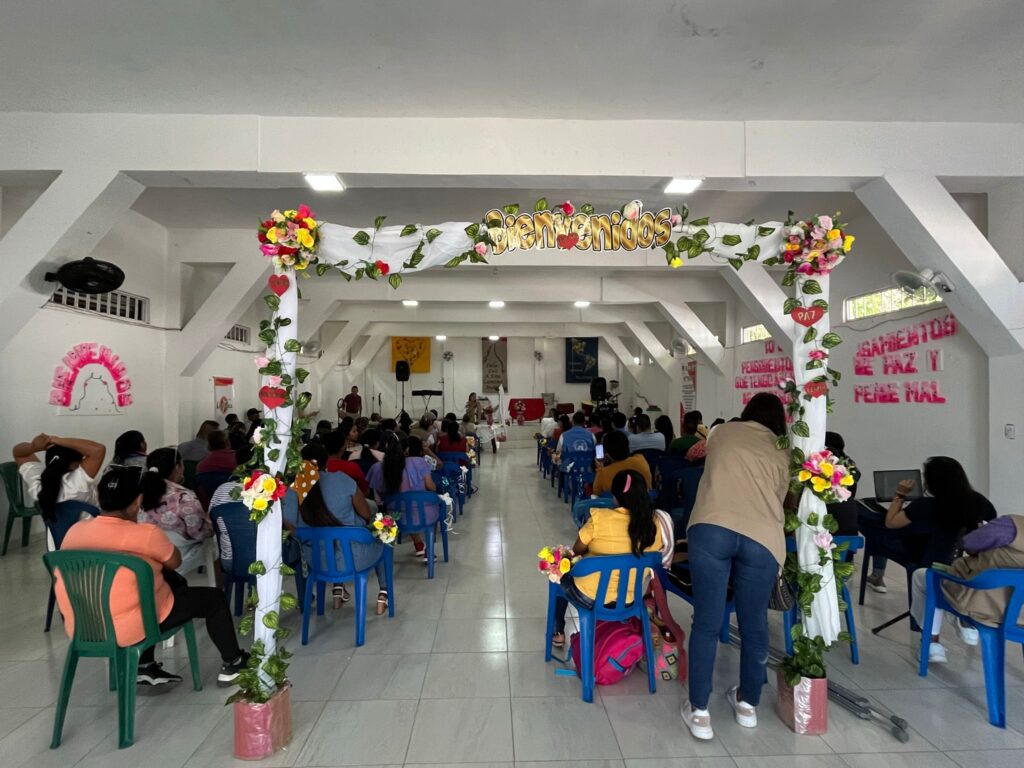
There are events that occurred more than 30 years ago and there are people who have disappeared for more than 30 years. Several of the peace signatories took out notebooks and wrote down: “Given the claims of people reported missing, we want to collect the information.” They know it’s not just data. But there is too much information that they do not have. They keep the notes, they make commitments, they run their hands over their heads, they know the damage done.
That same day, two representatives from among the signatories, and two from among the victims, came forward and grabbed the symbolic heart-shaped piece covered with threads. A person from the Afro community of Putumayo wore his ancestral attire while holding one of the edges of the heart: “As Afro people we can no longer bury our brothers. Violence is not only done with weapons but also when there is no forgiveness. This outfit gives a sign of forgiveness, a sign of commitment.” Shortly after, the representative of the victims’ table shared: “When we do not forgive, it is the illnesses of the soul that come forth. We cannot talk about reconciliation when there is hatred in our hearts.”
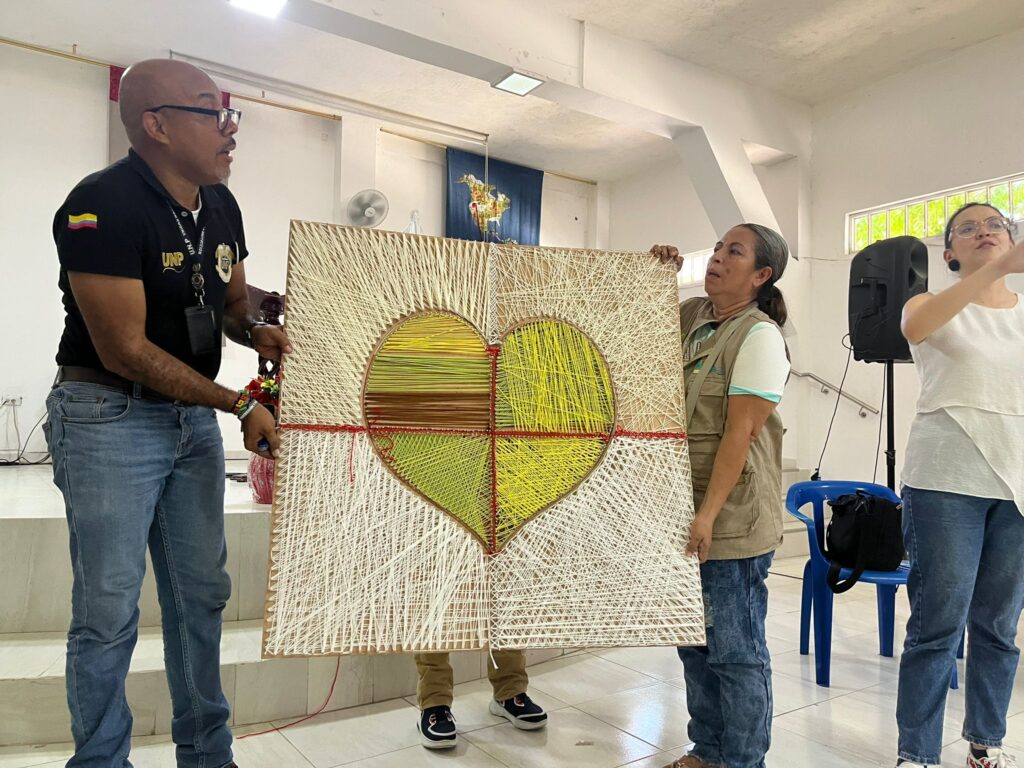
There was a minute of silence for those who were not among us. In the background you could hear motorcycles and cell phones ringing; there were birds and whirring fans; people who breathed, sighed and cried. Then the victims gave the peace signatories buttons with a white background and a black dove in the center that meant that, during pain, peace transforms suffering. They said: “For the people who have our forgiveness and reconciliation.” Then, the peace signatories handed out succulent plants to the victims and said: “Because reconciliation processes are fragile like plants and therefore deserve our care.”
At the end of the event, Father Miguel from the Catholic Church shared a few brief words to close the process. “We have to find peace in ourselves. Let these painful events not continue to be repeated. May the peace of Christ govern our lives. That as humans we can know how to put ourselves in the place of others.” It was surely the shortest homily of his life. Then we all prayed the Lord’s Prayer: “Forgive us our trespasses, just as we forgive those who trespass against us.”
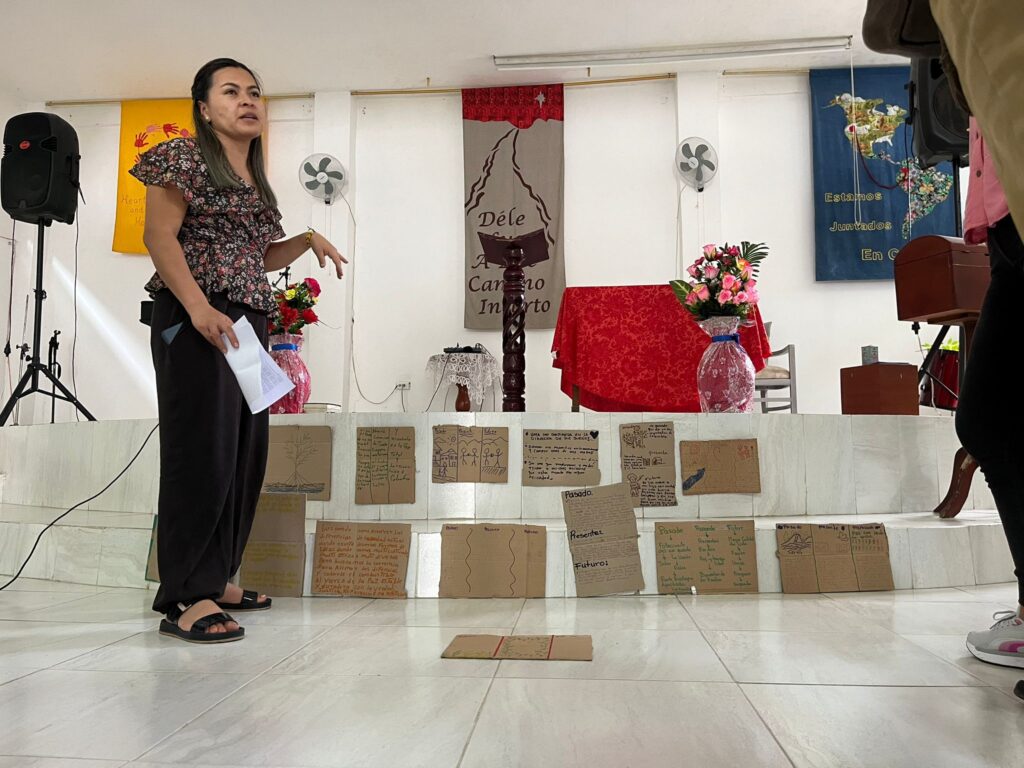
Reconciliation is not something that happens but something that is expected as a promise and we all inhabit it in its incompleteness. We live and work within the paths of that promise and weave things that way, trusting that days will not always be the same.
Alex and Xiomara’s appointments are made possible by your gifts to Disciples Mission Fund, Our Church’s Wider Mission, and your special gifts.
Make a gift that supports the work of Alex Maldonado-Lizardi and Xiomara Cintron-Garcia
Los Días No Siempre Iguales
El viernes, 25 de agosto, de Justapaz cuatro de nosotros llegamos a la sombra del árbol de mango frente al templo de la *Iglesia Cristiana Luz de Paz en Putumayo con cartulinas, marcadores, hilos de colores y la forma de un corazón en madera por piezas, desmontado. El objetivo para esos días era contribuir a los procesos de reconciliación entre firmantes del acuerdo y víctimas del conflicto de distintas regiones en el Putumayo correspondiendo lo que dispone el punto 5 del Acuerdo Final: «la satisfacción de los derechos de las víctimas es la reconciliación de toda la ciudadanía colombiana para transitar caminos de civilidad y convivencia». Pero, Putumayo es un departamento con 287,974 personas reconocidas como víctimas del conflicto armado de las 9,555,446 que transitan el duelo del país[1]. Según esta cifra, el 84% del departamento del Putumayo ha sido víctima del conflicto. ¿Cómo se reconcilia un país de tantas víctimas con sus responsables? ¿Cómo haríamos nosotros para que 60 víctimas y 6 firmantes se ubicaran en caminos de reconciliación?
Los seis firmantes de paz llegaron por río, sobre una barcaza larga como una espiga de trigo y metales. Viajan en camioneta y luego atraviesan el río en barco y nuevamente en carretera hasta la iglesia. Poco a poco van reformulando la cotidianidad. Algunos conformaron las filas de las FARC por 13 años o más. Uno de ellos ya es mayor de edad y fue parte de las FARC por más de 40 años. «Toda una vida en el monte», dice.
¿De qué manera hablan de reconciliación? Para ellos la firma, los procesos de perdón no solo son acciones humanitarias, sino actos políticos. Por lo tanto, la reconciliación tiene problemas metodológicos que no se resuelven solo a fuerza de fe. Porque la gran paradoja de la violencia en este país es que tiene un factor ordenador de la vida política, social y económica de la gente, y en la medida que ese orden se impone, se degrada la guerra, los tratados, los acuerdos, las convenciones, los derechos, y con todo esto los pueblos[2].
El encuentro era un espacio simbólico y espiritual de reconciliación. Contó con tres momentos para conocer las historias de vida de la gente y comprender la capacidad de perdón y reconciliación tanto de los firmantes como de las víctimas y con cada grupo escribimos y dibujamos con cuidado nuestros caminos de vida en pedazos de cartón que luego fuimos recogiendo y mirando en silencio sobre un peldaño del altar de la iglesia. Eran tantos que acabamos pegándolos en una de las paredes. A cada tiempo de vida que compartimos le asignamos un hilo de un color. Representaban el territorio o la tierra luchada, la esperanza en el presente y el futuro como un amanecer que extiende las promesas asignadas mientras vivimos con el peso de las cosas. La vida es un hilo que tendemos con otros, pero aquí las historias surcan los mismos caminos porque la violencia no distingue ni segrega los eventos y el dolor de las víctimas y los victimarios.
Hay eventos que ocurrieron hace más de 30 años y gente desaparecida hace más de 30 años. Varios de los firmantes sacaban libretas y anotaban: «Ante los reclamos de personas dadas por desaparecidas, queremos recoger el dato». Ellos saben que no son solo datos. Pero es demasiada la información con la que no cuentan. Guardan las notas, hacen compromisos, se pasan la mano por la cabeza, saben del daño.
Ese mismo día dos representantes de entre los firmantes, y dos de entre las víctimas pasaron al frente y agarraron la pieza simbólica en forma de corazón toda atravesada de hilos. Una persona de la comunidad afro del Putumayo llevó puesto su atuendo ancestral mientras sostenía uno de los bordes del corazón: «Como pueblo afro no podemos más sepultar a nuestros hermanos. La violencia no se hace únicamente con las armas sino cuando no hay perdón. Este atuendo da señal de perdón, da señal de compromiso». Poco después, la representante de la mesa de víctimas compartía: «Cuando no perdonamos son las enfermedades del alma las que vienen. No podemos hablar de reconciliación cuando en nuestro corazón hay odio».
Hubo un minuto de silencio por quienes no están entre nosotros. De fondo se escuchan las motos y celulares sonando; hay pájaros y ventiladores que zumban; gente que respira, suspira y llora. Entonces las víctimas repartieron a los firmantes botones con un fondo blanco y una paloma negra en el centro que significaba que, en medio del dolor, la paz transforma el sufrimiento. Decían: «Para las personas que tienen nuestro perdón y reconciliación». Luego, los firmantes repartieron plantas suculentas a las víctimas y decían: «Porque los procesos de reconciliación son frágiles como las plantas y merecen nuestro cuidado».
Al final del acto, el padre Miguel* de la iglesia católica compartió unas palabras escuetas, para el cierre del proceso. «La paz tenemos que encontrarla en nosotros mismos. Que no se sigan repitiendo estos hechos dolorosos. Que la paz de Cristo gobierne nuestras vidas. Que como humanos sepamos como ponernos en el lugar de otros». Seguramente fue la homilía más corta de su vida. Entonces todos rezamos el Padre Nuestro: «Perdona nuestras ofensas, así como nosotros perdonamos a quienes nos ofenden».
La reconciliación no es algo que ocurre sino algo que se espera como una promesa y todos la habitamos en su incompletud. Uno vive y trabaja dentro de las rutas de esa promesa y teje las cosas así, confiando en que los días no siempre serán iguales.
[1] https://www.unidadvictimas.gov.co/es/reporte-de-caracterizacion/37398
[2] Gonzalo Sánchez, «La violencia», en Caminos de guerra, utopías de paz: Colombia: 1948-2020, (Bogotá: Planeta, 2021), 29.
